Scottish Folds – To purr or not to purr!?
Find out when does your Scottish Fold purr and how to groom it
To purr, or not to purr: that is the question. Are you looking to get a cat for the sake of their calming purr? Or do you already own a Scottish Fold and you wonder whether their purring habits are normal or not? You’ve come to the right place.
We’ll address these questions and grooming concerns of Scottish Fold companions next. But first, let’s see what that soothing and lovely sound is. (and yes, if you are that curious, Scottish Folds purr)
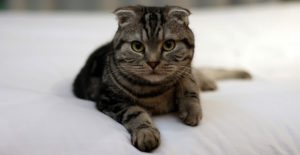
How and why do cats purr?
Research on cats purring behavior cannot point an exact mechanism. Along the way, people who studied this habit went through various theories.
How
How: the most recent theory says that purring comes from a combination of muscle activity. A neural oscillator makes the laryngeal and diaphragmatic muscles vibrate. This way, it controls the air passing through. Purring happens during inhaling and exhaling of the cat. As unique as every cat, the purr can come out loud and clear or silent and low.
Why
Why: there is a whole list of reasons why your kitty cat purrs in different situations. People are most familiar with the fact that cats purr when happy. It is true, but aside from that, many other emotional states are expressed through purring. After all, we don’t always smile because we are feeling good.
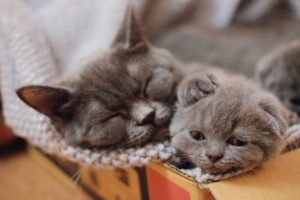
Mother cats purr during labor to help with the pain and relax the muscles. After birth, they purr to help the kitten stay close and nurtured. When born, baby cats are blind and deaf and the vibration of the purr brings them close to the mother’s body. The vibration of the purr regulates body temperature and keeps warm.
Kittens start purring at 2-days of age. Purring and kneading is a way of communicating with the mother and of stimulating milk flow. This combination of purring and kneading can stick all the way into adulthood. No cat owner ever complained about that!
Other reasons
Contentment: When your cat is fully relaxed, no tail wiggles or anything it’s a sign of happiness. Purring, in this case, is a good feeling type of purr for sure.
Scottish Fold has their cute & weird positions they like to sit. If you find them on their back, stretched with their paws up and purring, you have a joyful cat.
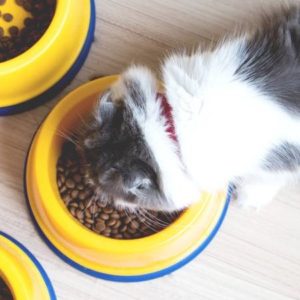 Hunger: mealtime purring does not sound the same. Cats know how to use this tools to their advantage. A study from the University of Sussex, UK found that hunger purrs have similar frequencies to that of a baby cry. Researchers call it “soliciting purr”. Pay attention next time your cat asks for food. You will find their purring compelling and your hand already in the fridge.
Hunger: mealtime purring does not sound the same. Cats know how to use this tools to their advantage. A study from the University of Sussex, UK found that hunger purrs have similar frequencies to that of a baby cry. Researchers call it “soliciting purr”. Pay attention next time your cat asks for food. You will find their purring compelling and your hand already in the fridge.
Healing: Cat purrs are therapeutic for them and for us. When in pain or hurt, cats soothe themselves by purring. The vibration from low-frequency purrs can help with:
- Bone and wound healing
- Muscle and tendons repairing
- Easy breathing
- Less pain
Next time your cat purrs, pay attention to their behavior that led to purring. You might get a new perspective on their emotional state.
Do Scottish Folds purr?
Yes, like any other cat, Scottish Folds purr. However, they are less vocal than other breeds.
Affectionate in nature and human-friendly, the Scottish Fold goes well in large families. They are playful and intelligent and loneliness does not suit them. But, they will get attached to one favorite caregiver and stick to them.
Compared to other cats, the Scottish Fold has a soft voice and their meows and purrs are not that noticeable. They have a complex repertoire of noises and sounds that you can’t find in other breeds, but they come out in a gentle, low voice.
Note (to keep you from getting upset): Scottish Folds are not so much lap cats. They prefer sitting curled up next to you. Do not take it personally, they love you just the same.
Do Scottish Folds shed a lot of hair?
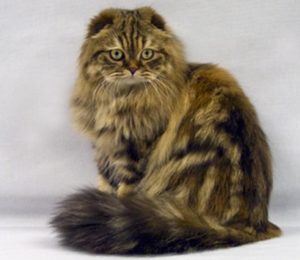 You recognize them by their Foldies, the cute ears out of sight. But how about their coat style!?
You recognize them by their Foldies, the cute ears out of sight. But how about their coat style!?
Scottish Folds are either short or long-haired. Originally, they were bred to have white coats. Now, the coat color comes with a huge pallet of choices, much like paint samples.
Short-haired Folds have dense, thick fur and soft at touch.
Long-haired ones have a very dense coat, in particular around the tail, ears, toes and upper thighs.
Similar to the British Shorthair, this breed is double-coated, hence the density of the fur. Because of this, they are bound to shed quite a lot. When we say cats shed during spring and autumn it does not mean that the rest of the time is hair-free. Scottish Folds will shed most of the year, but more so in spring and/or autumn.
The long-haired type has a reputation for gifting you with mats of silky hair. Also, if they spend time outdoors on a regular basis, it will prompt them to shed more. Cats that spend all their time indoors, will likely shed evenly throughout the year.
Advice: If you suffer from cat allergies, a Scottish Fold is not suitable for your home. They produce the allergenic protein Fel d1 in fair amounts. Also, their dense fur retains and carries it all around along with dust.
How to groom a Scottish Fold
Coat
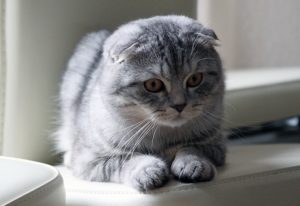 A cat with cute Foldies is not high maintenance. Yet, it depends on their hair type and the living environments.
A cat with cute Foldies is not high maintenance. Yet, it depends on their hair type and the living environments.
The short-haired kind that is found most often in people’s houses requires medium efforts. Brushing once a week to get rid of the extra coating and keep it soft should be enough.
The Highland Fold with its long hair will need twice a week or even daily brushing. Cats love the spoil of combing. It gives them a gentle massage and you will find your pet purring with joy.
If you skip the regular brushing, your home will have new rugs out of Scottish Fold hair. Not to mention that your kitty will wear out-of-fashion tangles.
In case you live in a house with outdoor space, probably your Scottish Fold is roaming around from time to time. This makes them shed more than an indoor cat with peak periods in spring and autumn.
Nails
To maintain healthy claws, trimming every 1 or 2 weeks does the job.
If you are a cat owner, you know they are not friends with nail clipping. It is no easy task, but after you establish a routine and a strategy, things should run smoothly. Watch the video below to get more insight into the art of cat nail trimming and set a schedule.
When cutting, make sure to snip only the white part of the claw. The pink part or the quick is the sensitive area with blood vessels and nerves. If you go there, your cat might stay clear of you for a while.
Ears
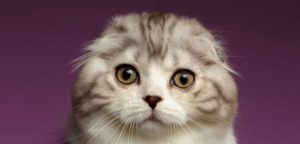 Ears don’t need regular cleaning but inspect them from time to time folding them back with care. Healthy and clean ears are dirt-free, are pink in color and have little to no earwax.
Ears don’t need regular cleaning but inspect them from time to time folding them back with care. Healthy and clean ears are dirt-free, are pink in color and have little to no earwax.
When they look dirty, use a gentle cleanser that your vet recommended and a cotton ball. Avoid the ear swabs, you can do more damage by accident. Plus, the cat will not be still to help you do a better job.
Teeth
Yes, you read well! Cats need tooth brushing as well. They too develop teeth and gum problems and brushing can help prevent them. Dental issues like tooth decay, bad breath, and gum disease occur in 8 of 10 cats.
Brush your Scottish Fold’s teeth on a regular basis with a toothpaste that you vet approves. Take a look in the video below how to properly do it if you are new to this.
Tip: Start to introduce nail trimming and teeth brushing early on. If you do it when they are only kittens, they will grow to accept these activities.
In general, cats are meticulous groomers and they clean extremely well reaching even the back of their ears. But this is no reason for you to lie back and not pay attention to their health.
Other aspects to take care of
Obesity
Obesity – Scottish Folds have a tendency to gain weight if overfed. Make sure to provide a healthy diet and have playing sessions. If left alone for long periods and living indoors, cats will become sedentary. Let them outside to explore and play.
Breeding
Breeding – if you want your cat to leave some heirs behind, choose a breeding program. Scottish Folds can develop certain health problems like skeletal abnormality and arthritis. This is the reason why Folds are never to be bred with Folds, both with folded ears.
When getting a Scottish Fold, watch for stiff legs and tail.
Periodic vet exams are highly recommended to prevent health problems and take good care of your pet.
Being cute, purring and playing does not make for a healthy cat. When deciding to take on a pet cat you need to be aware of its needs. A poorly groomed and cared cat is a suffering cat. A healthy and happy cat, on the other hand, will purr with joy!
How do you take care of your Scottish Fold?